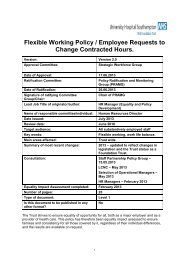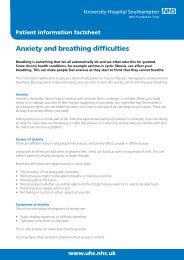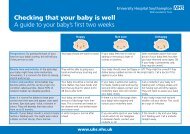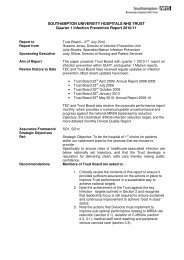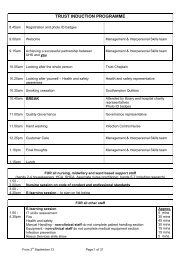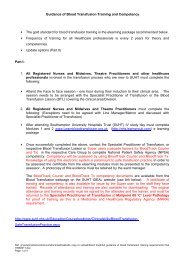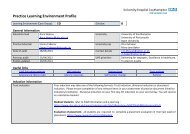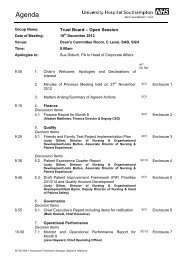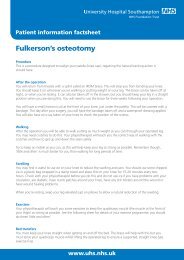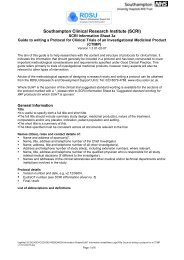Paediatric cardiology clinical profile - University Hospital ...
Paediatric cardiology clinical profile - University Hospital ...
Paediatric cardiology clinical profile - University Hospital ...
You also want an ePaper? Increase the reach of your titles
YUMPU automatically turns print PDFs into web optimized ePapers that Google loves.
COMMON DRUGS USED IN PAEDIATRIC CARDIOLOGYDiureticsFRUSEMIDE (Furosemide)Uses :Dose :Side-effects :Interactions :Strong loop diureticRemoves fluid from around heart and lungsUseful in management and prevention of CCFTreatment of hypertensionUsually 1mg/kg oral, NG or IVMay be given QDSLow potassium due to strong diuretic effectHypotension due to strong diuretic effectDecrease in diuresis with NSAID’sMore profound hypotensive effect if used alongside ACE inhibitors or beta blockersSPIRONOLACTONEUses :Dose :Side-effects :Weak diureticPotassium sparing-used alongside Frusemide to maintain potassium levelManagement and prevention of CCFUsually 1mg/kg oral or NGMay be given QDSRisk of developing high potassium if given at higher dosesInteractions :Notes :Increased potassium level with ACE inhibitorsIncreased potassium levels with NSAID’sMay elevate Digoxin level-risk of toxicityMay be given alongside Captopril until maintenance dose is achieved, thendiscontinued as risk of high potassium.
Beta BlockersPROPRANOLOLUses :Short acting affect1)Prevention of cyanotic spells in Fallots Tetralogy2)Management of Cardiomyopathy3)Treatment of arrhythmias4)Treatment of hypertensionDoses :Side-effects :1)250mcg-1mg TDS2)500mcg/kg TDS3)250-500mcg/kg4)1mg/kgBradycardiaHypotensionDizzinessTDSTDSInteractions :Notes :Increased AV conduction time with DigoxinAdrenaline increases blood pressure, risk of bradycardiaAnaesthetic decreases heart rate, lower cardiac outputDiuretics may increase hypotensive effectContra-indicated in patients with existing hypotension or heart blockATENOLOLUses :Dose :Notes :Long acting effectTreatment of hypertension1-2mg/kg dailyOralSame side-effects and interactions as PropranololMore commonly used in older children
DIGOXINUses :Dose :Side-effects :Interactions :Notes :Management of Atrial Flutter and SVTTreatment of CCFSlows and steadies the heart rate, allowing greater filling time, stronger contractionsand improved cardiac outputInitial loading dose (not IV)Maintenance 5mcg/kg BD, orallyToxicity leading to lethal arrhythmiasLevels may increase if used along-side Amiodarone, Flecainide and SpironolactoneRisk of toxicity is increased if used along-side diureticsContra-indicated in patients with heart block and Wolff-Parkinson-WhitesyndromeBlood level needs to be monitored to prevent toxicityFLECAINIDEUses :Dose :Interactions :Notes :Treatment and management of SVT, VT and ventricular ectopics2mg/kg TDS IV bolus or oral100-250mcg/kg/hr IV infusionIncreases Digoxin levelReduces effect of Beta BlockersDoubles effect of AmiodaroneCo-enhances effect if given with PropranololContra-indicated in patients with AF, SA Node Dysfunction, Heart Block, or BundleBranch Block
Analgesics and AntipyreticsPARACETAMOLUses :Dose :Analgesic for mild painAntipyretic10 – 15mg/kg, 4 – 6hrlyMax 80mg/kg/day500mg – 1gm max QDS over 12yrsSide-effects :Notes :Occasional rashesOverdose can lead to irreversible liver damageParva lax is the antidoteSafe for Mother to use if breast feedingOnly give with good liver functionIBUPROFENUses :Dose :Non-Steroidal-Anti-Inflammatory-Drug (NSAID)Analgesic for mild to moderate painAntipyretic5mg/kg, 6-8 hrlyMax 20mg/kg/day200 – 600mg max QDS over 12yrsSide-effects :Interactions :Notes :Gastrointestinal symptoms, including bleedingRashEnhanced Warfarin effectIncreased risk of low potassium with ACE inhibitorsSafe for Mother to use if breast feedingOnly give with good renal functionDICLOFENAC (VOLTAROL)Uses :Dose :Side-effects :Interactions :Notes :NSAIDLong lasting analgesic for moderate painAntipyreticUsually 500mcg – 1mg/kg max TDSGastrointestinal disturbancesRashesIncreases effect anticoagulantsIncreases Digoxin levelsRisk of nephrotoxicity with diureticsSafe for Mother to use if breast feedingOnly give with good renal function
CODEINE PHOSPHATEUses :Dose :Side-effects :Notes :Opioid analgesic for moderate pain ONLY in children over 12 years of age500mcg – 1mg/kg, 4 – 6hrlyRespiratory depression, sedation and constipationSafe for Mother to use if breast feedingMORPHINE SULPHATEUses :Opioid analgesic for acute or post-operative painDose : Oral 200 – 400mcg/kg, 4 – 6hrlyIV infusion10 – 30 mcg/kg/hrSide-effects :Notes :Nausea, vomiting, drowsiness, respiratory depression, urinary retentionNaloxone is the antidoteNeeds to be withdrawn gradually if used long-term, as patients can developdependence type symptomsAnticoagulants and AntithromboticsASPIRINUses :Dose :Side-effects :Interactions :Anti-thrombotic therapyThins blood by destroying plateletsUsed in patients with shunt dependant circulationsTreatment of persistent pericardial effusionsTreatment of PericarditisTreatment of Kawasakis DiseaseAnalgesic with anti-inflammatory and anti-pyretic properties (not recommendedunder 12yrs)Usually 5mg/kg daily, to max 75mg dailyMay have 10mg/kg daily depending on Consultant preferenceMay have up to 30mg/kg for effusions, pericarditis or KawasakisRisk of bruisingGastrointestinal irritationIncreased side-effects if given with other NSAID’sIncreased risk of bleeding if given with other anticoagulantsInteracts with anticonvulsant medicationsHEPARINUses :AnticoagulantInhibits the production of thrombinIncreases clotting timeShort and fast acting – used to maintain anticoagulation in patients normally onwarfarinDose : Either : Initial IV loading dose : Or :Up to 75iu/kg IV bolus 20iu/kg/hr IV infusionFollowed by :20iu/kg/hr IV infusionDose adjusted according to APTRSide-effects :Interactions:Risk of excessive bleeding or bruisingIncreased anticoagulant effect if used with Aspirin
WARFARINUses :Dose :Anticoagulant1)Used in management of Prosthetic valves2)Used in management of Fontana circulation3)Used in management of cardiomyopathy and in some conditions where risk ofpooling and turbulent flowUsually 100-200mcg/kg daily, orallyDose varied according to INRTarget INR Values :1) 3 – 42) 2 – 33) 2 – 3NB. Normal INR 0.8 – 1.2Side-effects :Risk of excessive bleeding and bruisingRisk of haemoptysisRashHair lossInteractions :Notes :Aspirin, NSAID’s, and Amiodarone and antibiotics can all affect INR and worsensymptomsMonitored on venous blood sample in hospital, dose adjusted accordingly. Usuallytested weeklyPatient may have home Coaguchek machine which tests on capillary blood sample
Specialised Cardiac DrugsADRENALINE (EPINEPHRINE)Uses :1 st line drug used in resuscitationDose :Baby/child 1 st dose 0.1ml/kg of 1 in 10,0002 nd /subsequent doses 1ml/kg of 1 in 10,000Older children 1 st dose 1ml/kg of 1 in 10,0002 nd /subsequent doses 1ml/kg of 1 in1,000RAPID IV/IO BOLUSSide-effects :Tremor, tachycardia, arrhythmias, headache, dizziness, vomitingNotes : May be given via ET tube, dose needs to be multiplied by 10DINOPROSTONEUses:Dose:Side-effects:Notes:To maintain patency of ductus arteriosus in patients with duct dependant lesionsTo encourage PVR to fall artificially soon in preparation for cardiac surgery5 –25ng/kg/minContinuous IV infusionRapid effect, short half-lifeApnoea, bradycardia, hypotension, flushing, pyrexia, peripheral vasoconstrictionRisk of necrotising enterocolitisEffect is reversed if O2 is given-ask before administering



